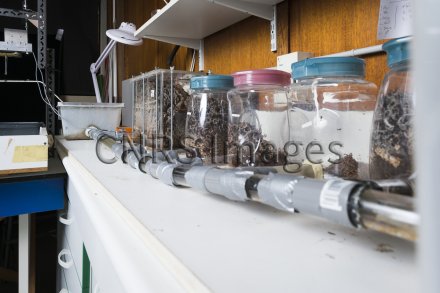Production year
2017

© Cyril FRESILLON/CRCA/CNRS Images
20170048_0084
Experimental device reproducing the structure of a colony of the fungus-growing ants Atta laevigata. The jars, linked via tubes, contain the various spaces of the colony, from the nest chamber hollowed out inside the fungus Leucoagaricus gongylophorus to the dump where the anthill waste is deposited. Atta ants, tropical ants from South America also known as leafcutter ants, live in symbiosis with the fungus Leucoagaricus gongylophorus, which they feed and feed from in turn. The ants known as "majors" or "soldiers" use their powerful jaws to cut the leaves into pieces, which are then transported by the medium-sized workers. The "minors" follow a chemical trail marked on the ground all the way to the nest. They take the sections of leaf, cut them up into smaller pieces and use them to cultivate the fungus, building their nest by hollowing out chambers inside it. In this way, Leucoagaricus gongylophorus proves to be indissociable from the life of the colony.
The use of media visible on the CNRS Images Platform can be granted on request. Any reproduction or representation is forbidden without prior authorization from CNRS Images (except for resources under Creative Commons license).
No modification of an image may be made without the prior consent of CNRS Images.
No use of an image for advertising purposes or distribution to a third party may be made without the prior agreement of CNRS Images.
For more information, please consult our general conditions
2017
Our work is guided by the way scientists question the world around them and we translate their research into images to help people to understand the world better and to awaken their curiosity and wonderment.